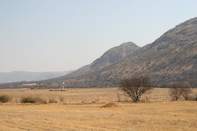A Relatively Young Science
The unusual geological characteristics of the Vredefort Dome had been noted by scientists as early as 1878. Something momentous had clearly occurred in the region, but no-one could agree on what. At that time, geology was a relatively young science and the dynamics of extra-terrestrial impacts were poorly understood.

Furthermore, the original crater (or astrobleme) was partially covered by newer sediments and the dome was heavily eroded. For the next century, a controversy over the origins of the Vredefort Dome would rage. The initial, and popularly accepted, hypothesis was that the Dome was created by a huge volcanic eruption from below the Earth’s surface.
This would have explained the overturned rock layers, the uplifted section of ancient granite and the presence of glassy melt rock. But the pressures exerted by an internal intrusion or explosion did not explain all the strange deformations and geological obscurities of the dome. Nevertheless, the dominant scientific theory of ‘crypto-volcanism’ (volcanic activity of a mysterious kind) was taken as fact.
No Compelling Alternative
The problem was, at the time, there was no compelling alternative. The science of astronomy was still emerging from its shroud of heresy, and humans had not yet travelled into space for an inter-planetary perspective. It was also problematic that many of the older astroblemes were now buried, transformed or even obliterated by geological processes, and thus difficult to identify.
As a result, common wisdom simply did not consider the possibility of a large extra-terrestrial impact and most of the visible craters on Earth were thought to have been caused by internal forces. Even the gaping craters on the moon were thought to have been caused by volcanic activity (which was partially true).
It was only in 1892 that a well-respected geologist, named Grove Karl Gilbert, published a paper suggesting that the craters on the moon were caused by asteroid strikes. Several other scientists also published papers in a similar vein. Then, at the turn of the century, an American businessman turned his attention to a small but very well-known crater located in Arizona desert.
Daniel Berringer
This man, name of Daniel Berringer, had examined rock samples from a simple bowl-shaped crater, then known as Coon Butte, and found them to contain a strange kind of nickel-iron. He came to believe that this mineral was part of a meteorite (suitably named ‘Canyon Diablo’) that had crashed into the Earth, forming the 1.2km wide crater and embedding itself in the crater floor.
Berringer’s cunning plan was to mine the crater and extract the nickel. It was a simple plan but, as it turns out, he was only half-right. Barringer and his investors bought the crater and poured thousands of dollars into mining activities.
Sadly, no payable amounts of nickel were ever found. It appears that the Canyon Diablo meteorite had pretty much vaporised on impact, leaving behind only small traces of its iron core. Nevertheless, in 1906, Barringer and a colleague prepared a report about the impact origin of the crater and gave the feature a new name, Meteor Crater.
Despite the collapse of the mining operation, the Barringer family maintained ownership of the crater and it is now a popular tourist attraction, sometimes called Barringer Crater in honour of its champion.
Drawn into the Debate
Barringer’s assertions about impact origins drew attention to Meteor Crater and scientists began to investigate a number of similar structures around the world. Throughout the 1920s and 30s, researchers (often working independently of each other) produced papers suggesting an impact origin for both lunar and terrestrial craters.
On the other hand, the cryptovolcanic camp was still dominant and kept producing research in support of their hypothesis. The Vredefort Dome was inevitably drawn into the debate. In the 1940s, the tide began to turn. Two books were published, ‘Between the Planets’ and ‘The Face of the Moon’, which popularised the idea that the lunar craters were created by meteor impacts.
In 1946, a list identifying confirmed meteorite craters on Earth was published. There were only 10, including Meteor Crater, and all of them had to contain actual meteorite fragments to qualify. But the movement was gaining momentum.
By David Fleminger